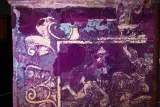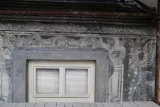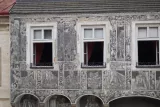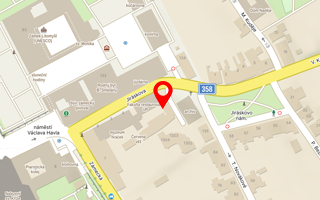Carried out by: Verena Fialová, Eliška Miklovičová, David Svoboda, DiS., Adéla Škrabalová (3rd-year students of the Bachelor’s degree programme) and BcA. Ivana Milionová, BcA. Markéta Renzová (1st-year students of Master’s degree programme)
Teaching supervision: MgA. Zuzana Wichterlová
On the facade, there are motifs from the Old Testament, illustrations from the Metamorphoses by Ovid and portrait medallions of the Habsburgs ruling at that time. Around the images, there are frames with inscriptions and scroll frames adorned with flowers, leaves and mascarons. The original decoration of the plinth has not been preserved.
It is the type of shaded sgraffito from the late 16th century where the intonaco is coloured with charcoal to a dark grey shade. The shading was carried out by the method of trowel shading, which was commonly used in the Slavonice region in the Renaissance. Later (in the 17th century), the sgraffito was covered with plaster or lime wash. It was rediscovered in 1924 when it was uncovered and restored. There were further conservation treatments in the 20th century (in the 50s, 70s and 90s).
The survey found out that the sgraffiti on the geison, gable, bay storey and below it were of various states of preservation. The main issue was the critical condition of the plaster on the attic gable. The plaster was detached more than a few centimetres off the masonry in several areas.
The plaster of the gable storey was in quite a satisfactory state of preservation – with a few areas of authentic surface carrying the original shading. Under the gable storey, in the rain shadow, unsuitable residues of coloured layers and fixing agents of the past restoration treatments were left. The area of the plinth was affected with water-soluble salts.
A whole range of issues had to be solved during the conservation treatment. In the area of the attic gable, the detached plaster had to be consolidated with lime nanosuspension and then grouted extensively with commercial injection grout (Ledan TC1) mixed with marble dust, in bigger hollows with a self-prepared grout. As the pressing tool, a firm grating with a flexible net was used. Secondary layers, fixing agent residues or sulfate crusts in the rain shadow were reduced (with the use of ammonium-carbonate poultices). In the plinth sections, the reduction of water-soluble salts was carried out by the application of poultices in three cycles.
Intonaco (black intonaco coloured with charcoal) was filled (completed) with a mortar based on aerial lime. A high proportion of charcoal and artificial binding particles (calcium carbonate) were added to the mixture. As analogies to the sgraffito, historical photographs (from the 20th century) and Renaissance graphic sheets depicting the motifs were found and used in the process of retouching and reconstruction. For the reconstructions, we also used photographs taken in sharp raking light in many various directions and subsequently adjusted with the use of a computer. The technique of retouching white areas (a white layer of limewash) consisted in leaving out the dark areas and retouching only the light ones. In this way, the original technique of shading sgraffito was imitated. Retouching was carried out with modified lime colours.
The restored facade was awarded the prize Monument of the Year 2015 in category 1 (smaller-scale monuments) by the Association of Historical Settlements of Bohemia, Moravia and Silesia.











